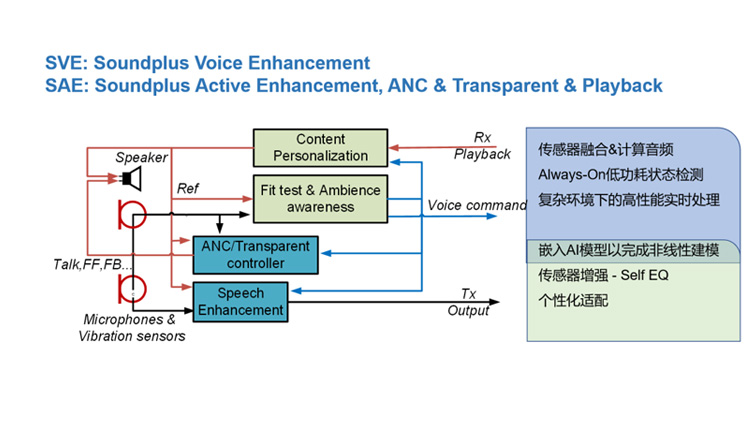In recent years, computational audio technology has been iteratively innovated one after another.
On the one hand, the application scenarios of wearable audio devices represented by TWS earphones are becoming more and more diversified. In addition to calls, the earphones’ application scenarios have been greatly expanded due to the rise of telecommuting, live broadcasting, and audio/video content production; the popularity of earphones with active noise reduction (ANC) function enables users to independently control environmental noise. Under such circumstances, how to optimize the user experience and how to avoid repeated wearings have become challenges brought by application scenarios.
On the other hand, it’s a challenge for the structural design. The size of the device is getting smaller and smaller, and it cannot have enough space to design the wind shelter structure like headphones. Therefore, the microphone is frequently exposed to the interference of wind turbulence, which affects the active noise reduction effect, transparent transmission experience and voice call recognition effect. In addition, changes in wearing conditions and personalized wearing methods will affect the listening experience. Challenges from the scenarios and wearings lead to the increasingly complex audio functions of the device. The earphone not only needs to play content, but also needs to pick up sound, respond quickly to sound commands, detect the environment, and perform signal processing.
Sound+ has been focusing on the core technology of communication acoustics, and is committed to solving the technical challenges faced by end-side equipment. Through constantly innovating and breaking through, the Company has formed a variety of solutions. At present, true wireless stereo (TWS) Bluetooth earphones from many well-known enterprises have adopted Sound+' TWS earphone solutions, providing a clearer, more comfortable and more convenient experience for human-to-human communication and human-machine interaction in complex scenarios.

Sound+ Voice Enhancement
SounPlus Voice Enhancement (SVE) solution has been applied to hundreds of millions of earphones and other products through IP authorization.
SVE solution innovatively combines machine learning technology and speech signal enhancement technology to improve the performance of the headphone sensor system in capturing target speech. Neural networks enable nonlinear modeling, which can be used to suppress dynamic noise have very superior performance. However, due to the extremely limited computing resources of earphone, using neural network to process speech alone will cause the risk of speech distortion. In this regard, Sound+ uses the traditional digital signal processing technology and adaptive beam technology at the front end to improve the signal-to-noise ratio of the neural network input signal, thereby improving stability.
This solution can be adapted to various forms of earphone products: sports in-ear, semi-in-ear or headset, etc., and it supports the use of single-mic to four-mic for voice enhancement configuration. At present, this solution has been widely used in TWS Bluetooth earphones of many well-known companies. Sound+ can provide recording samples of various configurations and audiometric evaluation of actual finished products.
-
01
High-Dynamic AEC
Acoustic Echo Cancellation(AEC) is a process that can remove echo from speaker, and it supports full-duplex. Feedback microphone will simultaneously receive high dynamic echo from the speakers when using it to pick up voice. AEC can suppress up to 70 dB of echo to improve voice quality.
-
02
Noise Reduction
Noise Reduction(NR) can detect and suppress stationary, non-stationary and transient noise of transmission and reception. Stationary noise includes background noise from vehicles, noise emitted by engines and ventilation equipment, etc. Non-stationary noise includes human voice, sounds from restaurants, etc. Transient noise includes whistles, and doorbells, etc.
-
03
Beam-forming
The beam-forming algorithm of Sound+ uses an array of two or more microphones to locate the direction of speech within the target range adaptively . It can enhance the speech of the target user and suppress environmental noise better. Sound+ combines beam-forming and specially trained DNN units to improve beam enhancement and stability, which provides smooth and high-quality speech signals in extremely complex noise environments with signal-to-noise ratios as low as -3dB.
-
04
Deep neural network processing unit
The deep neural network parameters are obtained through multiple iterations of training, especially designed for the characteristics of the headset signal contains tens of thousands of hours of training datasets, which can accurately separate the noise in complex acoustic environments. The neural network architecture is optimized for the efficiency of commonly computing platforms in headsets, so that AI computation can be completed under the premise of of low power consumption.
-
05
Multi-band EQ
Multi-band EQ Adjusts output frequency response of microphone and speaker to meet customer’s needs.
-
06
Automatic Volume Control – AGC, DRC
AGC enables output signal amplitude to be adjusted to the desired loudness. The Sound+ AGC module can dynamically adjust the output signal range, making the volume range of the entire audio signal more balanced, providing a more stable and comfortable auditory experience.
-
07
Post Filtering
The known echo signal and estimated noise signal are fed to the post-filter for nonlinear noise reduction and further suppression of the echo.Sound+ post-filter module is capable of suppressing noise while preserving the integrity of speech components to reduce speech distortion, and can be used for both uplink and downlink.
-
08
Inner ear microphone conditioning
The FB-EQ module will equalize the voice signal in the ear canal according to the current ANC parameter settings of the feedback microphone as well as the experimental optimization parameters, Improve the feedback microphone voice muffling, so that output timbre is highly reproducible.
-
01
Balance the sensitivity and robustness
-
02
Streamlined consumption of system resources
-
03
Low-power computing architecture
-
04
Easy to configure, tune and implement
-
05
Unique extra value-added features
- The noise
- The subway scene
- Wind noise scene
- Roadside scene





